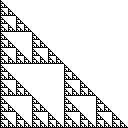9
The Sierpinski triangle is a set of points on the plane which is constructed by starting with a single triangle and repeatedly splitting all triangles into four congruent triangles and removing the centre triangle. The right Sierpinski triangle has corners at (0,0), (0,1) and (1,0), and looks like this:

Some equivalent definitions of this set are as follows:
Points in the
nth iteration of the process described above, for alln.Points
(x,y)with0 <= x <= 1and0 <= y <= 1such that for all positive integersn, thenth bit in the binary expansion of x and y are not both1.Let
T = {(0,0),(1,0),(0,1)}Let
fbe a function on sets of 2D points defined by the following:f(X) = {(0,0)} ∪ {(x+t)/2 | x∈X, t∈T}Then the right Sierpinski triangle is the topological closure of the least fixed point (by set containment) of
f.Let
Sbe the square{(x,y) | 0<=x<=1 and 0<=y<=1}Let
g(X) = S ∩ {(x+t)/2 | x∈(X), t∈T}(whereTis as defined above)Then the right Sierpinski triangle is the greatest fixed point of
g.
Challenge
Write a program or function which accepts 4 integers, a,b,c,d and gives a truthy value if (a/b,c/d) belongs to the right Sierpinski triangle, and otherwise gives a falsey value.
Scoring
This is a code golf. Shortest code in bytes wins.
Test cases
The following are in the right Sierpinski triangle:
0 1 0 1
0 1 12345 123456
27 100 73 100
1 7 2 7
8 9 2 21
8 15 20 63
-1 -7 2 7
The following are not in the right Sierpinski triangle:
1 1 1 1
-1 100 1 3
1 3 1 3
1 23 1 7
4 63 3 66
58 217 4351 7577
-1 -7 3 7
Is
-1 -3 1 1a valid input? – xnor – 2015-05-17T00:02:51.347Yes, that is a valid input. I've added test cases to make this clear. – cardboard_box – 2015-05-17T01:53:37.863